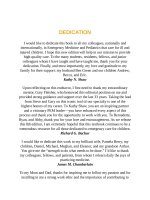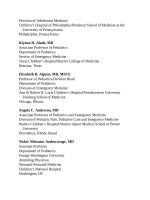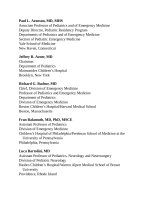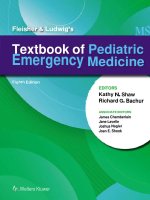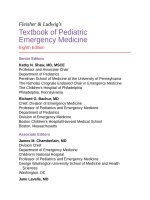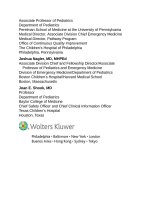Pediatric emergency medicine trisk 0234 0234
Bạn đang xem bản rút gọn của tài liệu. Xem và tải ngay bản đầy đủ của tài liệu tại đây (128.61 KB, 1 trang )
ETT, endotracheal tube; UVC, umbilical vein catheter. (Reprinted with permission. Circulation
. 2015;132:S543–S560. © 2015 American Heart Association, Inc.)
MANAGEMENT
Newly born infants who meet all three of the following criteria do not require
immediate resuscitation.
Term gestation
Good tone
Breathing or crying
These infants may stay with the mother for routine care, while maintaining
ongoing observation of breathing, activity, and color until transfer to definitive
care. Routine healthy newly born care includes the following: dry the infant,
place skin to skin with the mother, and cover in dry linen to prevent heat loss.
Newly born infants who do not meet any of the above criteria should be placed
on a radiant warmer and resuscitation steps initiated. Figure 9.17 includes the
steps in the Neonatal Resuscitation Algorithm, according to the 2015 AHA
Guidelines Update. Special attention should be paid to “the Golden Minute,” the
first 60 seconds allotted to completing initial steps, reevaluating, and beginning
ventilation if required.
Ventilation is the most important step for successful resuscitation of the newly
born infant who has not responded to the initial steps of warming, clearing and
repositioning the airway, drying, and stimulating. Progression to subsequent steps
is determined by simultaneous assessment of:
Respirations (apnea, gasping, labored or unlabored breathing)
Heart rate (less than 100/min)
If PPV or supplemental oxygen is initiated, response is determined by
simultaneous assessment of oxygen saturation along with the aforementioned
respirations and heart rate. Heart rate is the most sensitive indicator of successful
response to each step in the Neonatal Resuscitation Algorithm.

